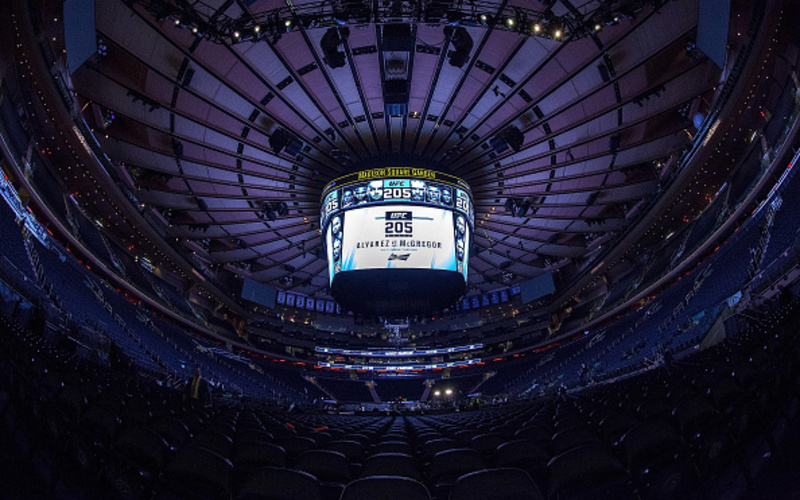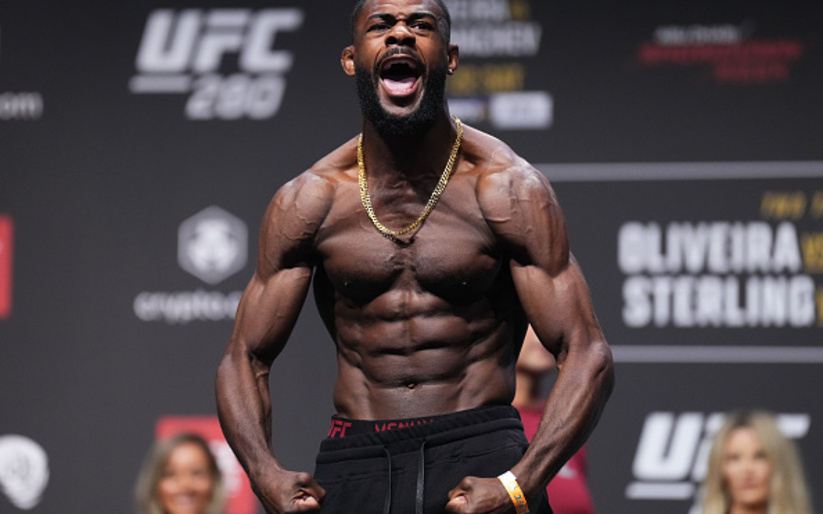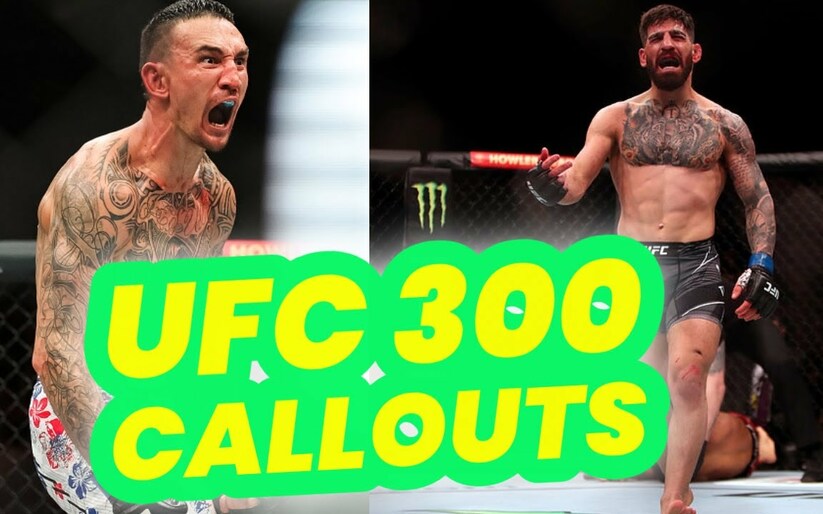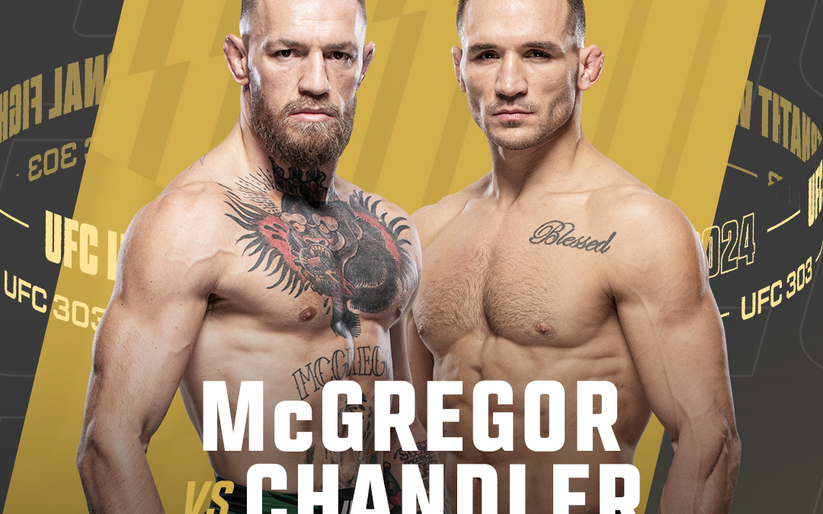For six hours on November 12, New York’s Madison Square Garden was the global epicenter of Mixed Martial Arts (MMA). This was a major departure from the states recent history as the lone holdout of MMA legalization. But after years of waiting, professional MMA finally came to New York, and the state is better off for it.
On March 22, New York finally took a long overdue step towards joining the rest of the country in sanctioning professional MMA (amateur MMA has existed in the state for many years). Though, there was a great deal of resistance from many within the state leading up to that moment. For years, as the sport of MMA–and its leading promoter the Ultimate Fighting Championship (UFC)—grew, New York was consistently against legitimizes the sport.
The inception of the MMA, and the UFC, coincide. When UFC 1 aired on Pay-Per-View (PPV) stations across the country in 1993, it revolutionized the business of professional fighting. It was devoid of many rules, and it was violent. While it gained a niche following, its brutality made many conservative bureaucrats view it negatively.
After Arizona Senator John McCain famously dubbed the sport “human cockfighting,” the industry, and UFC, almost collapsed from its taboo standing in the nation. Few states would legalize it, and even fewer PPV outlets were willing to broadcast it.
This was understandable, even from a fighter standpoint. “Back in its beginning stages, there were no rules, no regulations, no protection, no weight-classes, or limits. It was dog-fights with just humans,” says Destiny Quinones, 21, an amateur MMA fighter in Queens, New York.
It wasn’t until 2000 when the industry was given a new lease on life. At the behest of boxing manager/promoter Dana White, Stations Casinos (owned by brothers Frank and Lorenzo Fertitta) would purchase the UFC for $2 million. White would be placed in the role of president, and the parent company Zuffa would be formed to oversee it.
After the sale, one of the first mandates from the incoming management was to rehabilitate the industry’s damaged reputation. The only way to do that was by working with state athletic commissions, and bridging the gap towards legalization.
Rules were installed that outlawed barbaric attacks. A point-scoring system was created to mirror professional boxing. And events were promoted in a way to better resemble other pro sports, not blood-lusting spectacle. “With sanctioning, protection, rules and regulation, it has become a sport no different from boxing or Olympic tae-kwon-do,” says Quinones.
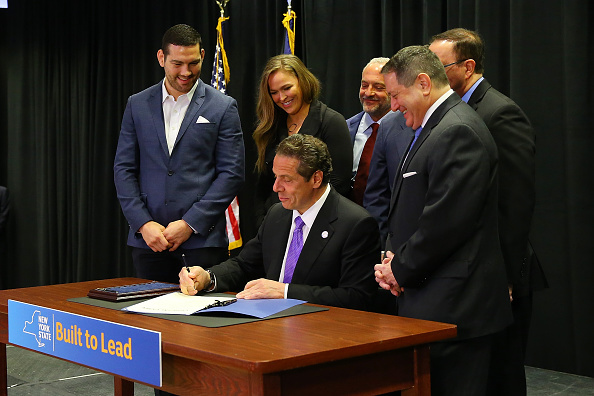
NEW YORK, NY – APRIL 14: New York Governor Andrew Cuomo is joined by (from left) UFC fighters Chris Weidman and Ronda Rousey, UFC CEO Lorenzo Fertitta, Madison Square Garden President James Dolan, Senator Joe Griffo and Assemblyman Joseph Morelle as he signs a bill to legalize Mixed Martial Arts fighting in the state during a ceremony at Madison Square Garden on April 14, 2016 in New York City. (Photo by Mike Stobe/Zuffa LLC/Zuffa LLC via Getty Images)
In time, these changes made a difference. And states who had bans on the industry, repealed their laws and allowed the sport back in. By 2011, West Virginia became the forty-fourth state to legalize MMA. In 2013 Connecticut became the forty-seventh state to legalize. By 2016, out of all the states with athletic commissions to oversee the sport, New York was the lone territory not yet willing to sanction professional MMA.
The greatest frustration, for the pro-legalization movement, came from being so close, so many times, to passing a legalization bill. On six separate occasions, a bill from the state senate to authorize MMA in New York was passed. Yet, every time, the bill was either denied during debate on the state assembly floor, or altogether ignored. For Jillian DeCoursey, 32, another amateur MMA fighter from Queens, New York, the failures were hard to understand. “I thought it was ridiculous. There was no reason for it to be illegal,” she said.
The resistance came despite the information revealed in a 2012 HR&A study into the economic impact of MMA in New York. Their study found that the industry could bring in $68 million in revenue annually, and $16 million just from two UFC events in New York City. These numbers were backed on November 12, when the UFC set company, and Madison Square Garden gate records, with a haul of $17 million from attendees to their UFC 205 event.
The study also found that 525 jobs could be created from producing events in various arenas inside the state. Such as the aforementioned ‘Garden, Brooklyn’s Barclay Center and The Times Union Center in Albany.
There have been many theories on why it was so difficult to get a bill passed in the state. DeCoursey blamed “politics and money” as the cause for the delays. And she is not in the minority on that belief.
For some time, the Fertitta Brothers and their casino company have battled with the organization Unite Here. Unite Here represents 12,000 union workers in Las Vegas, Nevada–the home of all of the Fertitta’s casinos. Unite Here also represents union workers across the country, including in New York.
In a show of solidarity–and force–pundits and insiders believe Unite Here has purposely lobbied against any MMA bill in the state, as a tactic for leverage in union dealings in Nevada. While this has not been confirmed, there is credence to the theory. Especially after former Assembly Speaker Sheldon Silver was arrested in January of 2015, for taking $4 million worth of “bribes and kickbacks.” So it was no surprise then, that just over a year after Silver’s arrest, the state would finally pass a bill legalizing the sport. The seventh try would be the charm.
As an aspiring professional fighter, DeCoursey was thrilled to be able to fight in her home state. However, it wasn’t without concerns. “I was excited [about legalization] but a little worried about what the regulations would be,” she said. She would find out she had good reason to worry.
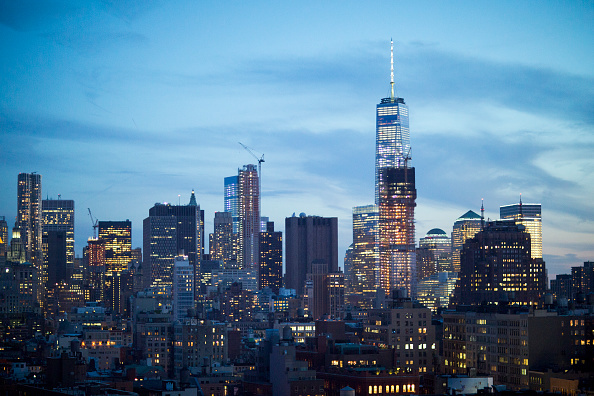
New York City Skyline View from the Annie O Music Series in the Penthouse at The Standard, East Village with Cimiotti & Mighty Challenger on May 20, 2015 (Photo by Nicky Digital/Corbis via Getty Images)
While the shackles were removed from promoters, an addendum added to the MMA bill has made MMA sanctioning beneficial to some, but not all. Because nothing can be easy when it comes to MMA in New York.
In November of 2013, boxer Magomed Abdusalamov suffered a serious beating during his heavyweight bout against Mike Perez at Madison Square Garden. Though he took serious damage during the fight, New York State Athletic Commission (NYSAC) officials were dubious in properly evaluating him after the fight.
Instead of being placed in an ambulance and sent to a hospital—for precautionary reasons—he was allowed to go home. While leaving the building he began to vomit and show signs of a worsening condition. Once he arrived at a nearby hospital, Abdusalamov suffered a stroke from a blood-clot he developed in his brain as a result of the fight. He would need to be put into a medically induced coma for several weeks to recover.
His family is currently suing the state for $100 million, because of how their relative was medically cared for after the fight.
Because of this latest instance of questionable decisions by the commission, New York Governor Andrew Cuomo insisted on a brain-injury insurance policy being required for all fighters on a professional MMA and boxing events. This is not a common practice in other states.
As a result, smaller promoters are not financially capable of paying for such policies. The UFC released the costs of insurance for their fighters at UFC 205. It cost the company $1,675 per fighter, and over $40,000 for the entire roster of combatants on the card.
Assembly Majority Leader Joseph Morelle has recently stated his concerns about these guideline’s effecting smaller promoters. But without adjustments, the state will not fully reach the financial potential other states get from legalized MMA.
Despite the uphill battle the sport has had in legitimizing itself in New York, the glass ceiling has been broken. The UFC—which was recently sold to William Morris Endeavors for over $4 billion—is finally showcasing their product in the largest media market in the world. Other notable organizations, like Bellator and World Series of Fighting, already have plans for events in the city. With the latter set to promote a show at Madison Square Garden on new year’s eve.
For fighters like Quinones and DeCoursey, who both plan to move to the professional ranks soon, legalization in New York not only helps local fighters like them, they feel it helps the sport as a whole. “NYC legalization of the sport just furthers the credibility and legitimacy of the sport,” said Quinones.
On November 12 the doors of opportunity to the greatest city in the world were opened. Opened to the fastest growing sport in the world. MMA, meet New York. New York, meet MMA. I think you two will become fast friends.
Main Photo:
